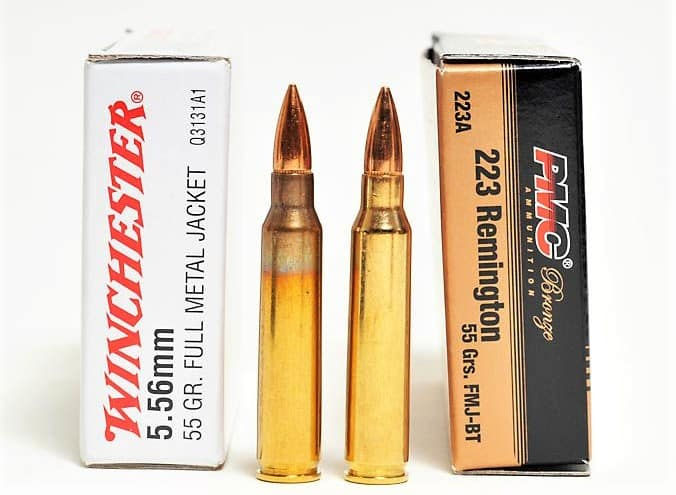5.56 NATO and .223 Remington: Not Entirely Interchangeable
- joe9838
- Mar 14
- 3 min read
Updated: Mar 15

The .223 Remington and 5.56×45mm NATO cartridges are often perceived as interchangeable due to their similar dimensions, but notable differences exist that can impact safety, performance, and suitability for various applications. This comprehensive guide delves into these distinctions, providing insights for shooters regarding interchangeability, performance in different scenarios, and best practices for firearm use.
Chamber Specifications and Pressure Differences
While the external dimensions of .223 Remington and 5.56 NATO cartridges are nearly identical, they differ in chamber specifications and operating pressures:
Chamber Design: 5.56 NATO chambers typically have a longer leade (the distance before the rifling starts) compared to .223 Remington chambers. This longer leade accommodates the higher pressures of 5.56 NATO rounds.
Operating Pressure: 5.56 NATO rounds are loaded to higher pressures than .223 Remington cartridges. Firing a higher-pressure 5.56 NATO round in a .223 Remington chamber, which is designed for lower pressures and has a shorter leade, can lead to increased chamber pressures, potentially causing malfunctions or damage to the firearm.
Interchangeability Considerations
Firing .223 in a 5.56 Chamber: Generally safe. The 5.56 chamber can handle the lower pressure of the .223 round, though there might be a slight decrease in accuracy due to the longer leade.
Firing 5.56 in a .223 Chamber: Not recommended. The combination of higher pressure and a shorter leade can result in excessive pressure, increasing the risk of firearm damage or injury.
The .223 Wylde Chamber
The .223 Wylde chamber is a hybrid design that accommodates both .223 Remington and 5.56 NATO rounds safely. It combines the tighter freebore diameter of the .223 Remington with the longer leade of the 5.56 NATO, allowing shooters to use either cartridge without significant safety or accuracy concerns.
Performance in Various Applications
Target Shooting: Both cartridges are popular for target shooting. The .223 Remington is often favored for its slightly lower recoil and marginally better accuracy at shorter distances, while the 5.56 NATO may be preferred for longer-range shooting due to its higher velocity.
Hunting: The choice between .223 and 5.56 depends on the game. The .223 Remington is suitable for small to medium-sized game, such as varmints and predators. For larger game, the higher energy of the 5.56 NATO can be advantageous, provided it's legal in the hunting jurisdiction.
Home Defense: Both cartridges can be used for home defense. However, it's crucial to select appropriate ammunition to minimize over-penetration risks.
Potential Cycling Issues with .223 in Semi-Auto 5.56 Rifles
Firing a .223 Remington round in a semi-automatic rifle chambered for 5.56 NATO generally does not present significant safety risks, but it can increase the likelihood of ejection failures or other cycling issues due to:
Lower Pressure in .223 Rounds: Semi-auto rifles rely on gas pressure from the fired round to cycle the action. The lower pressure of .223 rounds may result in insufficient force to cycle the action fully, leading to failures to eject or feed.
Gas System Tuning: Many 5.56 rifles are tuned to operate optimally with higher-pressure 5.56 NATO rounds. Using lower-pressure .223 rounds might result in cycling issues, especially in rifles with longer gas systems.
Recommendations for Shooters
Check Your Firearm's Specifications: Always verify whether your rifle is chambered for .223 Remington, 5.56 NATO, or .223 Wylde. This information is typically stamped on the barrel.
Select Appropriate Ammunition: Use ammunition that matches your firearm's chambering to ensure safety and optimal performance.
Consult Manufacturer Guidelines: Refer to your firearm's manual or contact the manufacturer if you're uncertain about ammunition compatibility.
Test Your Ammunition: Fire different brands and loads of .223 ammunition to identify which cycles reliably in your specific rifle.
Adjust Your Rifle: Consider using a lighter buffer or an adjustable gas block to fine-tune the gas flow if you plan to shoot .223 rounds frequently.
Maintain Your Rifle: Proper maintenance ensures that your rifle operates smoothly and reduces the risk of cycling issues.
Understanding the distinctions between .223 Remington and 5.56 NATO cartridges is essential for safe and effective shooting. By selecting the appropriate ammunition for your firearm's chambering and intended use, and by being aware of potential cycling issues when using .223 rounds in a 5.56 semi-auto rifle, you can enhance both safety and performance
Check out our ammo inventory and let us know if there's something you'd like that we don't have on the website or in stock. Our goal is to have everything you need so if we're lacking, say the word and we'll get it!
If you found this informative, we invite you to sign up for email notifications of new blog articles.
#223Remington #556NATO #AR15 #GunSafetyTips #AmmunitionBasics #RifleShooting #FirearmsEducation #TargetShooting #HuntingWith556 #HomeDefenseAmmo #ShootingSportsInfo #GunMaintenance #SemiAutoRifles #223WyldeChamber #RifleCartridgeGuide #HuntingInIowa #IowaOutdoors #MidwestHunting #IowaGunOwners #NWIOWAFirearms #IowaShootingRanges #IowaHunters
Comentários